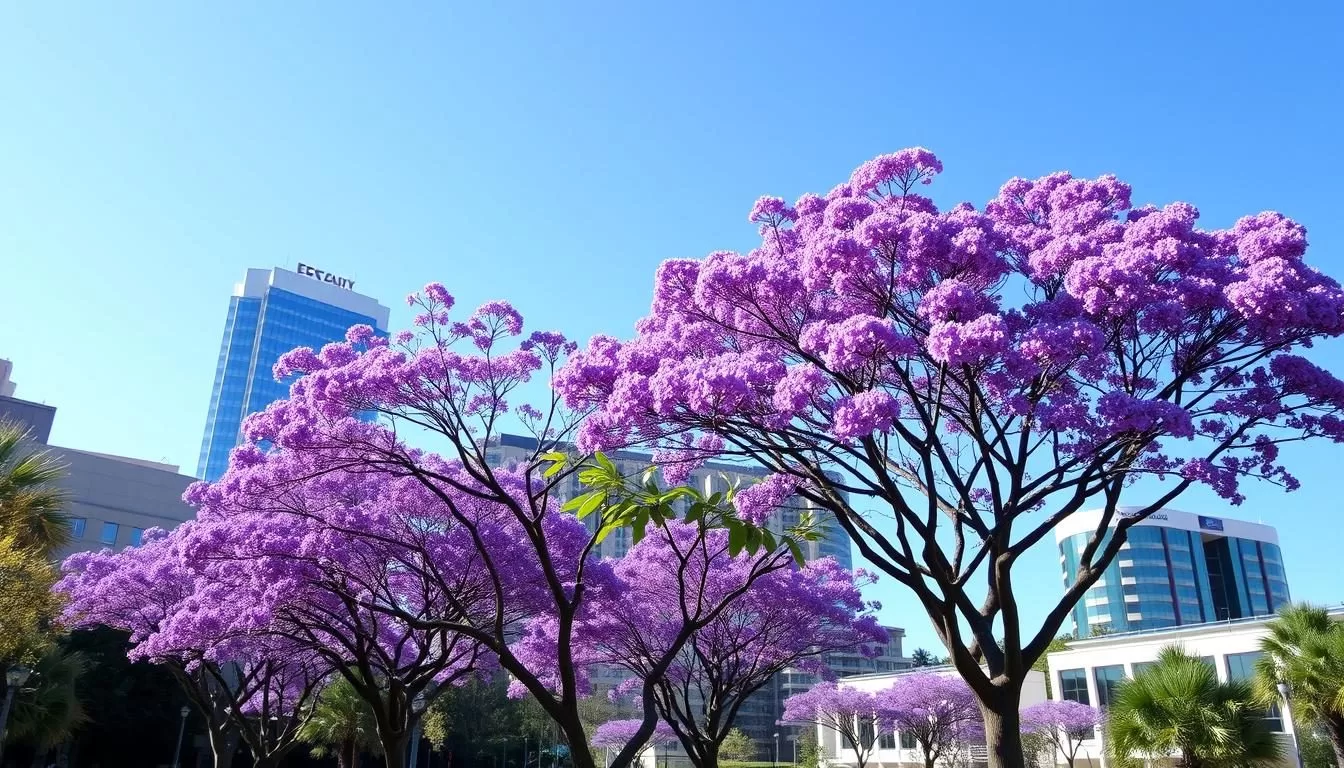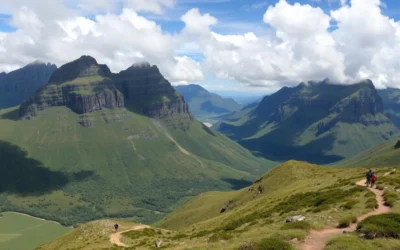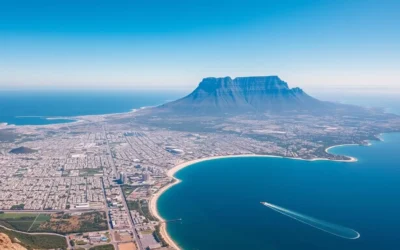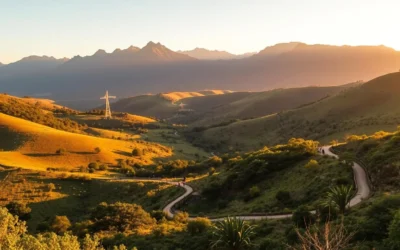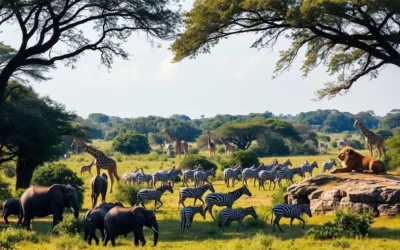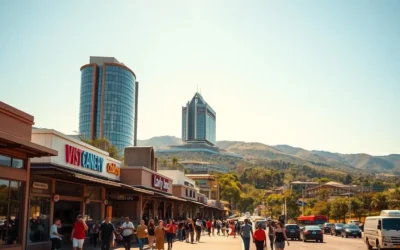✓ Accommodations✓ Flights✓ Rental Cars
Pretoria, South Africa: Best Things to Do – Top Picks
Pretoria, with its deep-rooted history and stunning natural beauty, is an unmissable stop for any traveler exploring South Africa. As the administrative capital, it boasts a rich cultural heritage and historical significance that is palpable throughout the city.
One of the city’s most striking features is its jacaranda trees, which bloom in spring, turning Pretoria into a purple paradise. This natural spectacle, combined with the city’s historical architecture and cultural attractions, makes Pretoria a must-visit destination.
Pretoria’s unique blend of historical significance and modern amenities appeals to a wide range of travelers. From history buffs to nature lovers, there’s something for everyone in this vibrant city. The city’s role in South Africa’s political landscape adds another layer of depth to its appeal, making it a fascinating place to explore.
In this comprehensive guide, we’ll take you through the top attractions and experiences that Pretoria has to offer. Whether you’re interested in history, culture, or simply enjoying the great outdoors, you’ll find that Pretoria is a city that will captivate and inspire you.
Discovering Pretoria: South Africa’s Administrative Capital
As you step into Pretoria, South Africa’s administrative capital, you’ll uncover a rich tapestry of history and culture. This city is not just a hub of governance but a treasure trove of historical landmarks, cultural experiences, and natural beauty.
Pretoria’s Historical Significance
Pretoria’s history dates back to the 19th century, and its significance is palpable in its architecture, museums, and monuments. The city played a pivotal role during the apartheid era and has since evolved into a symbol of unity and reconciliation. Visitors can explore the Voortrekker Monument, a testament to the city’s rich history and cultural heritage.
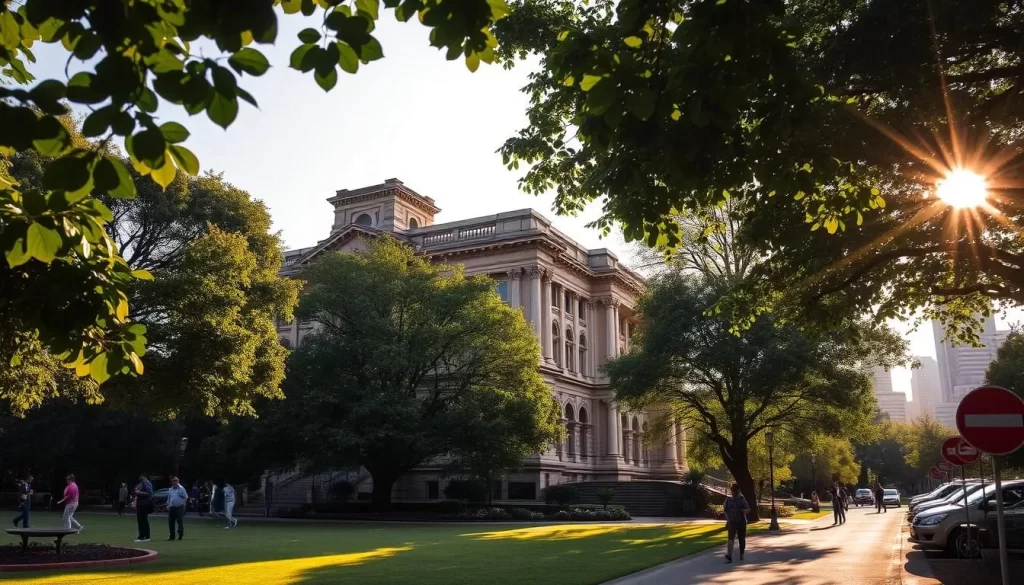
Best Time to Visit Pretoria
The best time to visit Pretoria is during the spring (September to November) and autumn (March to May) seasons, when the weather is mild and pleasant. The city’s famous jacaranda trees bloom in September, painting the landscape with vibrant purple hues. Summer can be hot, while winters are generally mild but cooler in the mornings and evenings.
| Season | Weather | Activities |
|---|---|---|
| Spring (Sep to Nov) | Mild and pleasant | Jacaranda blooming, outdoor activities |
| Autumn (Mar to May) | Mild | Comfortable sightseeing, cultural events |
| Summer (Dec to Feb) | Hot | Water sports, outdoor adventures |
Planning Your Trip Duration
Planning the duration of your trip to Pretoria depends on your travel style and interests. For a brief visit, 3-4 days is a good starting point to explore the main attractions. However, to experience the city comprehensively, consider spending 5-7 days. This allows you to visit historical sites, enjoy the local cuisine, and explore surrounding areas.
For day-trippers from nearby cities like Johannesburg, a well-planned day can help you see the highlights. Prioritize your must-see attractions and pace your visit to avoid exhaustion. Attractions like the Union Buildings and the National Zoological Gardens are must-visits, while others like the Pretoria Art Museum can be visited based on your interest in art.
- For a comprehensive experience, consider a 5-7 day itinerary.
- Day-trippers can prioritize main attractions like the Voortrekker Monument and Freedom Park.
- Pace your visit to avoid exhaustion and make the most of your trip.
Pretoria, South Africa: Best Things to Do – Top Picks
From historical landmarks to hidden gems, Pretoria offers a diverse array of activities for every kind of traveler. Whether you’re a history buff, a nature lover, or an art enthusiast, Pretoria has something to captivate your interest.
Must-See Attractions for First-Time Visitors
When visiting Pretoria for the first time, there are several must-see attractions that should be on your itinerary. The Union Buildings, for instance, are not only an architectural marvel but also hold significant historical importance as the seat of the South African government. You can take a guided tour of the buildings and enjoy the beautiful views of the surrounding gardens.
Another key attraction is the Pretoria Art Museum, which boasts an impressive collection of South African art. The museum’s collection includes works from the 19th century to the present day, offering a comprehensive overview of the country’s artistic evolution. Visiting this site allows you to appreciate the rich cultural heritage of South Africa.
The Sammy Marks Museum is also worth visiting, as it was once the home of Sammy Marks, a prominent industrialist and a key figure in South Africa’s industrial development. The museum provides insight into the life and times of Marks and his contributions to the region’s industrial growth, making it a fascinating visit for those interested in history and industry.
![]()
Hidden Gems Off the Tourist Trail
Beyond the popular tourist attractions, Pretoria has a number of hidden gems that are worth exploring. One such gem is the Wonderboom Nature Reserve, home to a 1,000-year-old wild fig tree. This reserve offers a tranquil escape from the city’s bustle, with walking trails and picnic areas that make it an ideal spot for nature lovers and families.
For those interested in exploring the local culture, visiting some of Pretoria’s residential neighborhoods can be a rewarding experience. Areas like Groenkloof and Menlo Park are known for their charming streets, local eateries, and small, privately-owned galleries. These neighborhoods offer a glimpse into the authentic Pretorian lifestyle, away from the typical tourist trails.
The Pioneer Museum is another lesser-known attraction that provides valuable insights into the lives of early settlers in the region. By exploring the museum, you can gain a deeper understanding of the challenges and achievements of the pioneers who shaped the area’s history.
When visiting these historical sites, it’s essential to be respectful of their significance. Taking the time to understand the context and history behind each location will enhance your appreciation and make your visit even more meaningful.
Union Buildings and Gardens
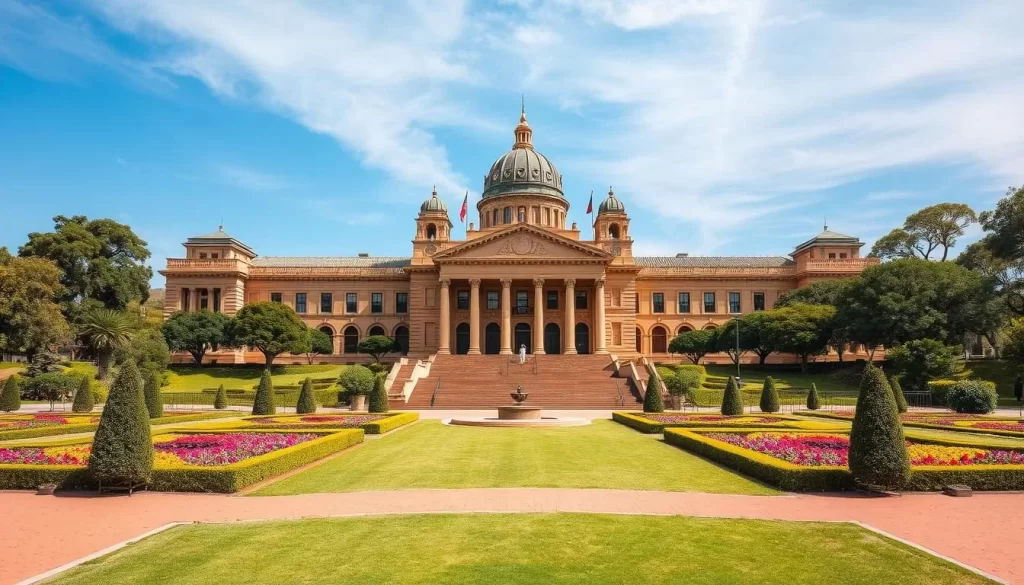
The Union Buildings in Pretoria, South Africa, stand as a testament to the country’s rich history and architectural grandeur. As the seat of the South African government, this complex is not only a significant historical landmark but also a symbol of the country’s governance and administrative functions.
Architectural Significance and History
The Union Buildings were designed by the renowned architect Herbert Baker and took several years to complete, finally being inaugurated in 1910. The complex is a masterpiece of architectural design, blending elements of neoclassicism with the natural beauty of its surroundings. The buildings serve as the official seat of the South African government, housing various government departments and serving as the venue for significant state events and ceremonies.
The architectural style of the Union Buildings is characterized by its use of local materials and its incorporation of historical elements, making it a unique example of architectural heritage in South Africa. The complex has undergone several renovations and expansions over the years to accommodate the growing needs of the government while preserving its original architectural integrity.
Nelson Mandela Statue
A significant feature within the Union Buildings complex is the statue of Nelson Mandela, the former President of South Africa and a key figure in the country’s fight against apartheid. The statue is a symbol of the country’s journey towards democracy and reconciliation. Visitors can view the statue and reflect on Mandela’s legacy, which is deeply intertwined with the history of South Africa.
The statue serves as a reminder of the country’s past and its progress towards a more inclusive and equitable society. It is a popular spot for tourists and locals alike, who come to pay their respects and reflect on the significance of Mandela’s leadership.
Exploring the Terraced Gardens
The Union Buildings are surrounded by beautifully maintained terraced gardens, which cover an area of 52 acres. These gardens are not only a peaceful oasis in the heart of the city but also a showcase of indigenous plants and landscaping features. Visitors can enjoy a leisurely walk through the gardens, taking in the various monuments and memorials located within the grounds.
The gardens offer a range of experiences, including guided tours that provide insight into the history and design of the gardens. Visitors can also enjoy picnic areas and pathways that offer stunning views of the surrounding cityscape. The gardens are a testament to the service of maintaining historical sites, ensuring that they remain accessible and enjoyable for future generations.
Voortrekker Monument and Heritage Site

As you visit Pretoria, the Voortrekker Monument is an unmissable attraction that offers a deep dive into the country’s past. This iconic monument is not only a significant historical landmark but also a site of great cultural importance.
Historical Importance and Architecture
The Voortrekker Monument is a majestic structure that commemorates the Great Trek of the Voortrekkers, pioneers who ventured into the interior of South Africa in the 1830s. The monument’s design and architecture are deeply symbolic, representing the challenges and triumphs of the Voortrekkers. Its construction was completed in 1949, and it has since become a symbol of Afrikaner heritage.
Architecturally, the monument is impressive, with a large granite structure that houses a museum and offers panoramic views of Pretoria from its observation deck.
Museum Exhibits and Artifacts
The Voortrekker Monument houses a museum that showcases a wide range of artifacts related to the Voortrekkers and their journey. The exhibits include wagons, clothing, and personal belongings of the Voortrekkers, providing a glimpse into their daily lives and struggles.
The museum also features dioramas and displays that depict significant events in the history of the Great Trek, making it an educational and engaging experience for visitors.
Panoramic Views from the Monument
One of the highlights of visiting the Voortrekker Monument is the opportunity to enjoy 360-degree panoramic views of Pretoria from the monument’s observation deck. To access the roof, visitors can use the elevator or stairs, and upon reaching the top, they are rewarded with breathtaking views of the city and the surrounding landscape.
The observation deck is equipped with telescopes that allow visitors to zoom in on key landmarks and get a closer look at the natural beauty surrounding the monument. For the best views and photography opportunities, it’s recommended to visit during the late morning or early afternoon when the lighting is optimal.
From the elevated vantage point, visitors can identify significant landmarks and appreciate the vastness of the heritage site. Tips for capturing memorable photographs include focusing on the contrast between the monument’s architecture and the natural surroundings, and making use of the telescopes to get detailed shots of distant landmarks.
Freedom Park: Celebrating South Africa’s Heritage

As you explore Pretoria, a visit to Freedom Park is a must, offering a poignant insight into the country’s complex history and its journey towards freedom. Located on a hilltop, the park provides a panoramic view of the city, serving as a symbolic link between the past and the present.
The Story of Freedom Park
Freedom Park is more than just a memorial site; it’s a celebration of South Africa’s journey to democracy. The park was conceived as part of the country’s Truth and Reconciliation process, aiming to honor those who contributed to the struggle for freedom and democracy. With its inauguration in 2004, it has become a significant cultural and historical landmark.
The park’s design and layout are deeply symbolic, representing the country’s diverse cultures and its complex history. As you walk through the park, you are surrounded by elements that narrate the story of South Africa’s past, from the pre-colonial era to the struggle against apartheid.
Wall of Names and Memorial Sites
One of the most striking features of Freedom Park is the Wall of Names, which honors those who lost their lives during the various conflicts and struggles that shaped South Africa’s history. The wall is a poignant reminder of the sacrifices made and serves as a place of reflection for visitors.
In addition to the Wall of Names, the park includes various memorial sites that commemorate significant events and figures in South African history. These sites provide a deeper understanding of the country’s past and its ongoing journey towards healing and reconciliation.
S’khumbuto and Hapo Museum
At the heart of Freedom Park lies S’khumbuto, the main memorial element, which translates to “place of remembrance” in the Nguni languages. S’khumbuto is a powerful symbol of the nation’s collective memory, honoring the individuals who played a crucial role in shaping South Africa’s history.
The Hapo Museum, meaning “dream,” is an integral part of S’khumbuto. The museum tells the story of South Africa across 3.6 billion years, divided into seven epochs presented on interactive page displays. Visitors can navigate the museum to learn about the country’s history, from pre-colonial times to the present day.
To make the most of your visit, consider guided tours, which provide insightful commentary on the park’s various elements. The park is open throughout the year, but it’s advisable to check the opening hours and plan your visit accordingly. Photography is encouraged, but be respectful of other visitors and the sacred nature of some areas.
National Zoological Gardens of South Africa

Pretoria’s National Zoological Gardens is a treasure trove of wildlife, conservation, and education. As you plan your visit, it’s essential to know what to expect from this vast and fascinating destination.
Africa’s Largest and Oldest Zoo
The National Zoological Gardens of South Africa, established in 1899, is not only a significant historical landmark but also a leader in wildlife conservation. Spanning over 85 hectares, it is one of the largest zoos on the continent, providing a home to a vast array of animals from around the world. The zoo’s commitment to conservation is evident in its breeding programs and educational initiatives.
Notable Animal Exhibits and Conservation Efforts
The zoo is renowned for its diverse animal collections, including rare and endangered species. Visitors can marvel at the majesty of elephants, lions, and giraffes, among others. The zoo’s conservation efforts are multifaceted, involving research, breeding programs, and community engagement. Notable exhibits include the reptile park, featuring a variety of snakes, crocodiles, and other species, offering a glimpse into the fascinating world of reptiles.
Conservation is at the heart of the zoo’s mission, with programs aimed at protecting and preserving biodiversity. These efforts are supported by educational programs designed to raise awareness about the importance of conservation.
Cable Car Ride and Aquarium
One of the highlights of a visit to the zoo is the cable car ride, which offers a panoramic view of Pretoria and the surrounding landscape. The ride takes you over the zoo’s hillside exhibits, providing a unique perspective on the animal enclosures and the gardens. To make the most of your visit, consider timing your cable car ride to avoid peak periods.
The aquarium is another must-see attraction, featuring both freshwater and marine exhibits. The underwater tunnel allows for an immersive experience, bringing you face-to-face with aquatic life. The aquarium is not only an entertaining experience but also an educational one, highlighting the importance of marine conservation.
When planning your visit, be sure to check the operational hours and ticket prices. The zoo prioritizes visitor security, ensuring a safe and enjoyable experience for all. By understanding the zoo’s layout and planning your day, you can make the most of your time and enjoy the various attractions without feeling rushed.
Pretoria’s Botanical Gardens and Green Spaces

As you explore Pretoria, you’ll discover a variety of stunning botanical gardens and green spaces that are perfect for relaxation. These areas not only provide a serene escape from the city’s bustle but also showcase the city’s commitment to preserving natural beauty.
National Botanical Garden
The National Botanical Garden in Pretoria is a must-visit destination for nature lovers. Spanning over 76 hectares, it features a diverse collection of indigenous plants and offers a peaceful retreat from the urban environment. You can stroll through the beautifully maintained gardens, explore the various plant species, and enjoy the tranquil atmosphere.
The garden is not just a visual treat but also provides environmental education services, making it an excellent spot for families and educational trips. With its well-marked trails and informative signage, visitors can easily navigate and learn about the different flora.
Jacaranda Trees and Purple Bloom Season
Pretoria is famous for its Jacaranda trees, which bloom with vibrant purple flowers during the spring season. The city’s streets and gardens are lined with these beautiful trees, creating a stunning display of color that attracts visitors from all over. The purple bloom season is a magical time to visit Pretoria, as the Jacaranda trees transform the city into a picturesque landscape.
Whether you’re looking to take a leisurely walk, enjoy a picnic, or simply bask in the beauty of nature, Pretoria’s Jacaranda trees offer a unique and unforgettable experience.
Austin Roberts Bird Sanctuary
The Austin Roberts Bird Sanctuary is an urban birding haven located within the Walkerspruit Open Space System. This sanctuary is home to over 170 bird species, making it a paradise for bird enthusiasts. The sanctuary’s bird hide facilities provide an excellent vantage point for observing birds in their natural habitat.
Visitors can enjoy guided bird walks and take advantage of the sanctuary’s environmental education services. The sanctuary is open throughout the year, and the best viewing times are during the early morning and late afternoon. With its accessible location and variety of bird species, the Austin Roberts Bird Sanctuary is a must-visit destination for anyone interested in bird watching.
To make the most of your visit, remember to bring appropriate equipment such as binoculars and a field guide. The sanctuary’s practical facilities, including walking trails and bird hides, ensure a comfortable and enjoyable experience for all visitors.
Museums and Cultural Attractions
As you explore Pretoria, you’ll discover a wealth of museums and cultural sites that offer insights into the city’s past and present.
Pretoria Art Museum
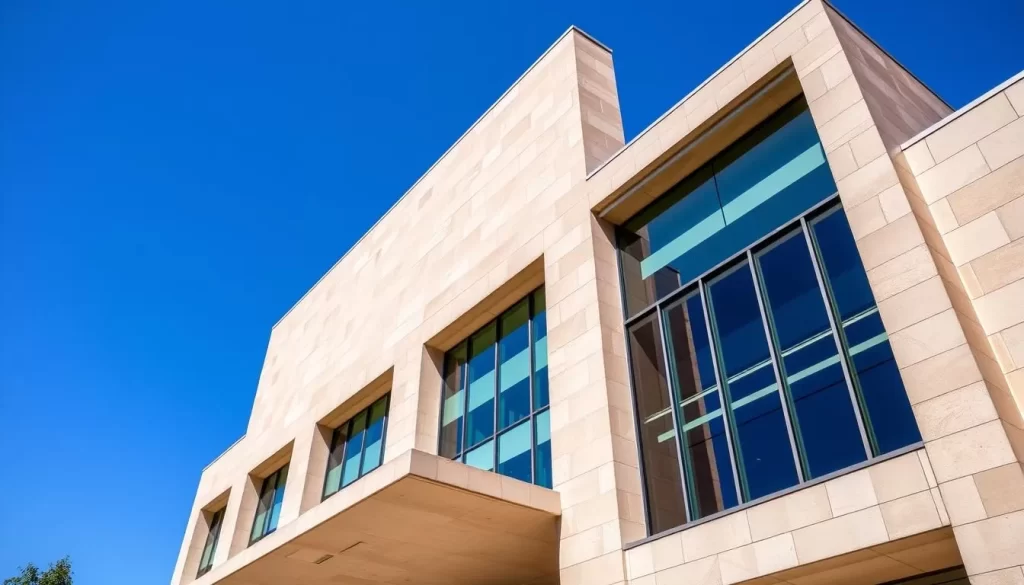
The Pretoria Art Museum is a premier cultural institution in the city, featuring a diverse collection of South African art from the 19th century to the present day. The museum’s holdings include works by prominent South African artists, offering a comprehensive overview of the country’s artistic development.
The museum’s exhibitions are regularly updated, ensuring that visitors can experience a wide range of artistic styles and themes. Whether you’re an art enthusiast or just looking to explore Pretoria’s cultural scene, the Pretoria Art Museum is a must-visit destination.
Ditsong National Museum of Natural History
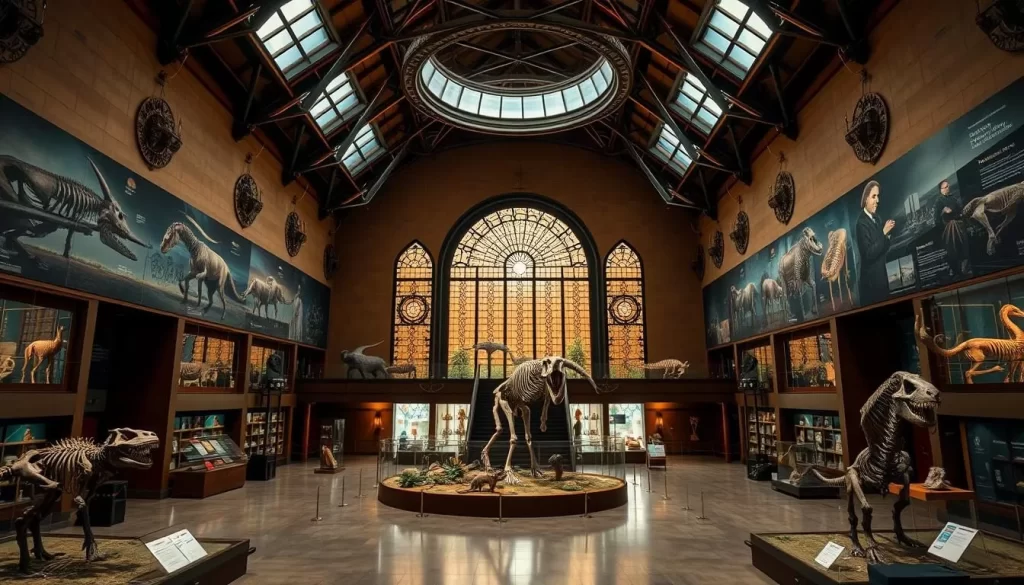
The Ditsong National Museum of Natural History is one of the largest and most significant natural history museums in South Africa. With a collection of over 600,000 specimens, the museum provides a fascinating glimpse into the country’s natural heritage.
Visitors can explore exhibits on topics such as dinosaurs, mammals, and the natural history of the region. The museum also offers interactive displays and educational programs, making it an ideal destination for families and those interested in natural history.
Melrose House Museum

Melrose House is a stunning example of Victorian architecture and a significant historical landmark in Pretoria. The house was built in the late 19th century and played a crucial role during the Anglo-Boer War, serving as the venue for the signing of the Peace Treaty of Vereeniging in 1902.
Today, Melrose House is a museum that offers guided tours, allowing visitors to explore its beautifully restored interiors and learn about its rich history. The house features period furnishings, art collections, and porcelain displays, providing a glimpse into the lives of Pretoria’s elite during the Victorian era.
The surrounding gardens and the original city block on which Melrose House stands add to its charm, making it a unique cultural attraction in Pretoria. Visitors can appreciate the architectural details and historical significance of this mansion, gaining a deeper understanding of the city’s heritage.
Culinary Experiences in Pretoria
The culinary experiences in Pretoria offer a delicious journey through South African cuisine. As you explore the city, you’ll have the opportunity to taste traditional dishes, dine at top-rated restaurants, and visit vibrant food markets.
Traditional South African Cuisine
Traditional South African cuisine is a melting pot of flavors, influenced by the country’s diverse cultural heritage. Popular dishes include bobotie, a savory meat pie, and boerewors, a traditional sausage. You can also try pap en vleis, a hearty dish made with maize porridge and meat. These dishes are not only delicious but also offer a glimpse into the country’s rich culinary history.
Top Restaurants in Pretoria
Pretoria is home to a variety of excellent restaurants, each offering a unique dining experience. Some of the top recommendations include restaurants that serve traditional South African cuisine, as well as those offering international flavors. You can enjoy a meal at a luxurious setting or opt for a more casual, laid-back atmosphere. The city’s top restaurants are known for their high-quality service and delicious food.
Some popular restaurants in Pretoria include:
- The Grill House
- Beluga Restaurant
- The Manhattan Brothers Coffee Shop & Bistro

Food Markets and Street Food
Pretoria’s food markets and street food scene is a must-experience. The Hazel Food Market, held every Saturday, offers a wide range of artisanal foods and local produce. You can also visit the Pretoria Boeremark (Farmers Market) for traditional South African foods and the Market@The Sheds for a variety of artisanal vendors. These markets are perfect for sampling local flavors and discovering new favorites.
Some must-try street food items include:
- Bunny chow
- Gatsby sandwich
- Boerewors rolls
Shopping Destinations in Pretoria
Shopping in Pretoria is a delightful experience, with a range of options from high-end malls to local craft markets. Whether you’re looking for luxury brands, unique local crafts, or simply a great dining experience, Pretoria has something for everyone.
Menlyn Park Shopping Centre
Menlyn Park Shopping Centre is one of Pretoria’s premier shopping destinations, offering a wide range of stores from international brands to local boutiques. With its modern architecture and spacious layout, it’s an ideal place to spend a day shopping and dining.
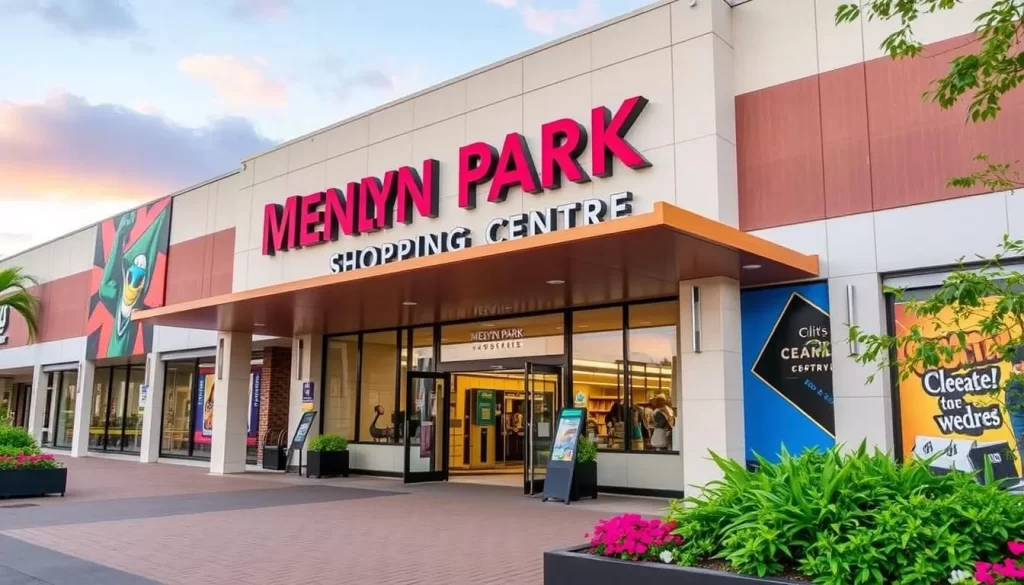
Brooklyn Mall and Design Square
Brooklyn Mall is another popular shopping destination in Pretoria, known for its diverse range of shops and eateries. The adjacent Design Square is a hub for local artisans and designers, offering unique gifts and souvenirs.
Hazel Food Market and Craft Markets
The Hazel Food Market is a must-visit for foodies and those looking for unique shopping experiences. It offers a variety of artisanal foods, handcrafted items, and local products. Pretoria is also home to other craft markets, such as the Pretoria Boeremark, where you can find authentic South African crafts and gifts.
When visiting these markets, be sure to check their operating hours and locations. You can often find this information on their websites. Bargaining is a common practice, so be prepared to haggle for the best deals. Additionally, many vendors accept various payment methods, including cash and credit cards.
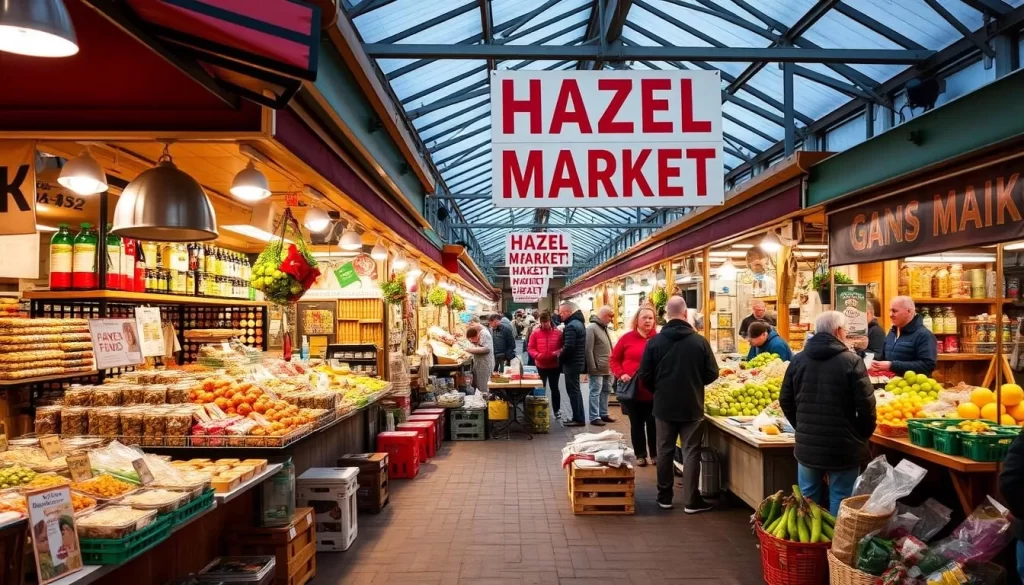
Day Trips from Pretoria
The area around Pretoria is rich in attractions, making it perfect for day trips that offer a mix of history, wildlife, and natural beauty. Whether you’re interested in exploring historical sites, experiencing the great outdoors, or simply enjoying recreational activities, there’s something for everyone.
Cullinan Diamond Mine

The Cullinan Diamond Mine, located about an hour’s drive from Pretoria, is a site of great historical significance. It’s where the famous Cullinan Diamond, the largest diamond ever discovered, was found. Visitors can take guided tours of the mine, learning about its history and the diamond mining process.
The mine offers a unique glimpse into South Africa’s mining heritage, with its vast open-pit areas and historic buildings. You can explore the mine’s museum and shop, where you can purchase diamond jewelry and souvenirs.
Dinokeng Game Reserve
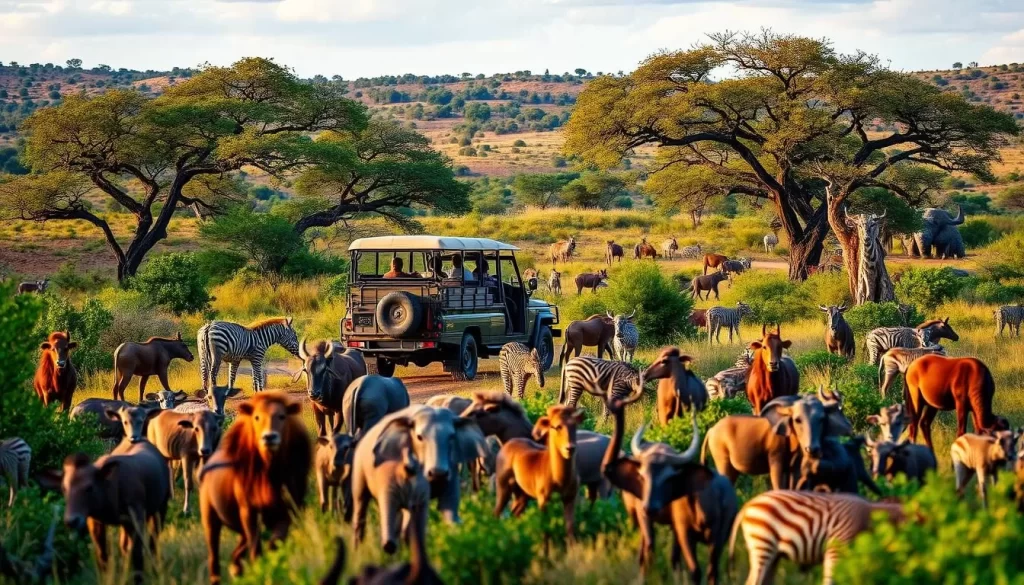
For those interested in wildlife, the Dinokeng Game Reserve is a must-visit. Located about an hour and a half from Pretoria, it offers a Big Five safari experience. The reserve is home to lions, leopards, elephants, buffalo, and rhinos, among other animals.
You can enjoy guided game drives, walking safaris, and even stay overnight at one of the lodges within the reserve. Dinokeng provides a unique opportunity to experience South Africa’s diverse wildlife in a relatively contained and accessible area.
Hartbeespoort Dam and Surroundings
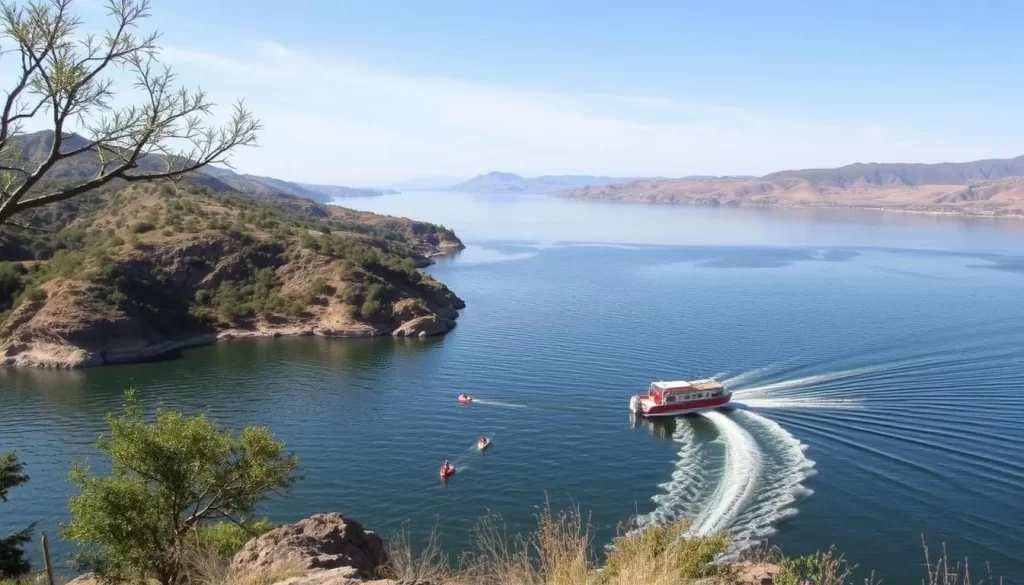
Hartbeespoort Dam is a popular recreational site, known for its beautiful scenery and water activities. You can enjoy boating, water skiing, and fishing, making it an ideal spot for those looking to relax and have fun.
The dam is surrounded by attractions such as the Elephant Sanctuary, Snake Park, and the Hartbeespoort Aquarium. You can also take a ride on the aerial cableway for panoramic views of the dam and its surroundings. The nearby French-themed village of Chameleon offers a charming spot for dining and shopping.
For a well-rounded day trip, consider visiting during the week to avoid crowds. Don’t forget to check out the scenic drives, particularly along the Hartbeespoort Dam wall, for breathtaking views.
Accommodation Options in Pretoria
Pretoria’s accommodation options are as diverse as the city itself, ranging from luxurious hotels to cozy guesthouses. Whether you’re visiting for business or leisure, you’ll find a place to stay that suits your needs and budget.
Luxury Hotels and Resorts
For a luxurious stay in Pretoria, consider booking a room at one of the city’s high-end hotels. These establishments offer top-notch amenities, fine dining options, and exceptional service. Some of the top luxury hotels in Pretoria include:
The 1885 Exclusive Stay and Protea Hotel by Marriott Pretoria Melrose Arch are notable mentions, offering elegant rooms and suites, along with excellent dining and recreational facilities.
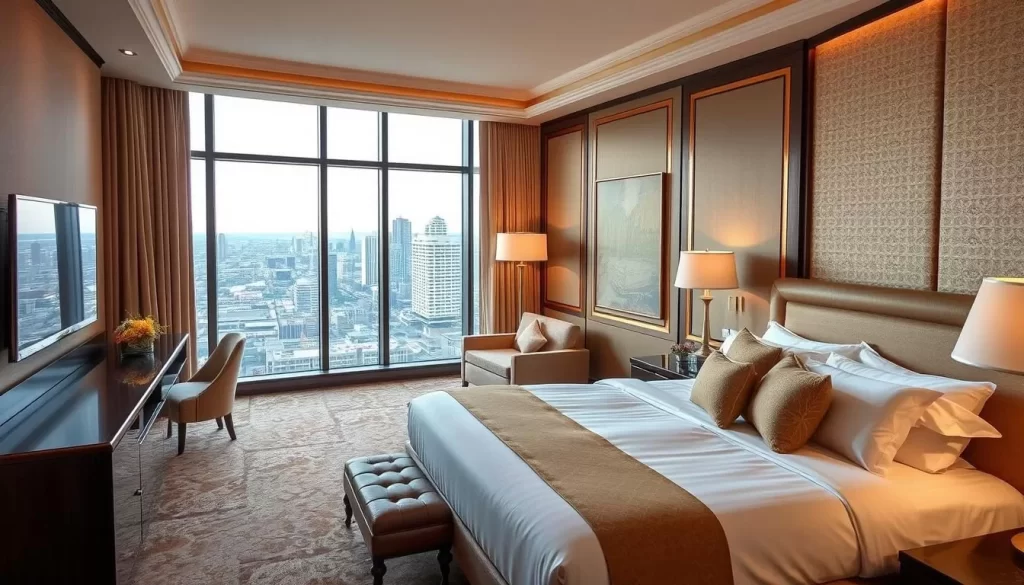
Mid-Range and Boutique Hotels
If you’re looking for something a bit more boutique or mid-range, Pretoria has a variety of options that offer great value for money. These hotels often have unique themes or designs and provide a more personalized experience. Some popular boutique hotels in Pretoria include:
One&Only Boutique Hotel and Pretoria Hotel, which offer stylish accommodations and excellent service.

Budget-Friendly Stays and Guesthouses
For travelers on a tighter budget, Pretoria offers a range of affordable accommodation options, including guesthouses, B&Bs, and self-catering apartments. These options are not only budget-friendly but also offer a chance to experience the local culture and hospitality. Some recommendations include:
Guesthouses like Amaryllis Guesthouse and La Quinta provide comfortable rooms and a warm welcome. For longer stays, self-catering apartments are a great option, offering more space and the flexibility to cook your own meals.

When choosing your accommodation in Pretoria, consider factors such as location, amenities, and reviews to ensure you find the perfect place to stay. Whether you’re looking for luxury, a boutique experience, or a budget-friendly option, Pretoria has something to suit every traveler’s needs.
Transportation in and around Pretoria
Whether you’re arriving or exploring, understanding Pretoria’s transportation network is key to a smooth trip. Pretoria, being the administrative capital of South Africa, is well-connected by various modes of transportation, making it relatively easy to get to and around the city.
Getting to Pretoria
Pretoria is accessible by air, road, and rail. The nearest major airport is the OR Tambo International Airport, located about 55 kilometers from Pretoria’s city center. From the airport, you can rent a car, take a taxi, or use a shuttle service to get to Pretoria.
If you’re traveling by car, Pretoria is connected to major cities like Johannesburg and Cape Town via highways such as the N1 and N4. For those preferring train travel, the Gautrain service connects Pretoria to Johannesburg, with stations in major hubs like Pretoria Station and Hatfield.
Public Transportation Options
Pretoria has a range of public transportation options, including buses and minibus taxis. The bus services, such as the Pretoria City Bus Service, cover a wide area of the city, providing an affordable way to get around. Minibus taxis are another popular mode of transport, although they can sometimes be crowded.
For a more comfortable and convenient experience, ride-hailing services like Uber and Taxify operate in Pretoria, allowing you to book a ride using your smartphone.
Car Rentals and Driving Tips
Renting a car is a great way to explore Pretoria and its surroundings at your own pace. Several major car rental companies, including Avis, Europcar, and Hertz, have operations in Pretoria, offering a wide range of vehicles.

When driving in Pretoria, be aware that South Africa drives on the left side of the road. Ensure you’re comfortable with this before renting a car. Additionally, be mindful of road signage and speed limits, which are generally well-marked.
To navigate Pretoria’s road network, consider using GPS navigation tools like Google Maps or Waze. These can help you avoid congestion and find the most efficient routes to your destination.
Parking in the city center and at major attractions is generally available, though it may require some patience to find a spot, especially during peak hours. Always follow local parking regulations to avoid fines.
For fuel, there are numerous stations throughout the city. In case of emergencies, roadside assistance is available through services like AA South Africa. It’s also a good idea to keep an emergency kit in your car, including items like a spare tire and first-aid supplies.
Practical Travel Tips for Visiting Pretoria
As you prepare for your trip to Pretoria, South Africa, it’s essential to consider several practical travel tips to ensure a smooth and enjoyable journey. Pretoria, being the administrative capital, offers a unique blend of historical significance, cultural richness, and natural beauty. Being informed about various aspects of your trip can significantly enhance your experience.
Safety Considerations
When traveling to Pretoria, safety should be a top priority. As with many major cities, it’s advisable to be aware of your surroundings, especially in crowded areas or at night. Keep your valuables secure and consider using reputable transportation services. Additionally, staying informed about local conditions and following local advice can help minimize risks.
It’s also a good idea to register with your country’s travel advisory department to receive important safety and security updates about Pretoria. Furthermore, being cautious with your belongings and avoiding displaying signs of wealth can help prevent petty theft.
Currency and Payment Methods
The official currency in Pretoria is the South African Rand (ZAR). While major credit cards are widely accepted in hotels, restaurants, and larger stores, it’s a good idea to have some local currency for smaller purchases and at local markets. You can exchange your currency at airports, banks, or currency exchange offices.
ATMs are readily available throughout the city, allowing you to withdraw cash as needed. Be aware that some ATMs may charge a fee for international transactions, so it’s wise to check with your bank beforehand. Many businesses, including restaurants and shops, also accept major credit cards like Visa and Mastercard.
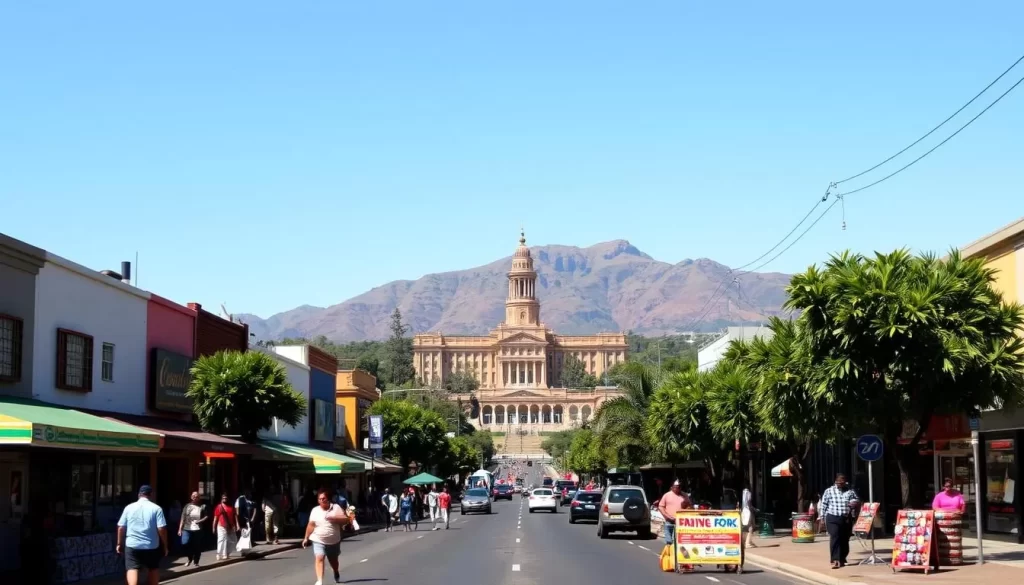
Weather and What to Pack
Pretoria experiences a subtropical highveld climate, characterized by mild winters and hot, rainy summers. The best time to visit is during the spring (September to November) and autumn (March to May), when the weather is mild and pleasant.
When packing, consider the season:
– For summer (December to February), pack lightweight, breathable clothing and sun protection, including a hat, sunglasses, and sunscreen.
– For winter (June to August), include warmer layers for cooler mornings and evenings, although temperatures rarely drop below freezing.
Regardless of the season, comfortable walking shoes are a must, as is a light rain jacket during the summer months when sudden showers can occur. Don’t forget to pack modest clothing for visits to conservative venues or cultural sites.
To adapt to sudden weather changes, particularly during summer, stay hydrated and be prepared with an umbrella or raincoat. Laundry services are available in most hotels and guesthouses, making it easier to refresh your wardrobe during longer stays.
Local business owners often recommend packing versatile clothing that can work across multiple settings, from casual outings to more formal events. Additionally, don’t forget sun protection necessities given Pretoria’s high altitude and sunny climate.
Best Time to Experience Pretoria’s Festivals and Events
If you’re planning to visit Pretoria, timing your trip to coincide with one of the city’s many festivals or events can greatly enhance your experience. Pretoria is known for its vibrant cultural scene, hosting a variety of events that cater to different interests.
Jacaranda Festival
The Jacaranda Festival is one of Pretoria’s most anticipated events, celebrating the city’s iconic jacaranda trees. The festival typically takes place in October, when the trees are in full bloom.
During the festival, the city hosts various activities, including cultural performances, food stalls, and art exhibitions. It’s a great time to experience the city’s vibrant atmosphere.

Cultural and Music Festivals
Pretoria is home to a diverse range of cultural and music festivals. These events showcase the city’s rich cultural heritage and provide a platform for local artists to perform.
From traditional music festivals to contemporary cultural events, there’s something for everyone in Pretoria. Be sure to check the city’s event calendar to catch the latest happenings.
Sporting Events
Sporting events are a significant part of Pretoria’s event calendar, with the city hosting various international and local matches. Rugby fans can catch a game at Loftus Versfeld Stadium, home of the Blue Bulls.
Cricket enthusiasts can enjoy matches at SuperSport Park in Centurion, while soccer fans can watch games at various venues across the city. Additionally, Pretoria hosts annual running events, including the Pretoria Marathon.
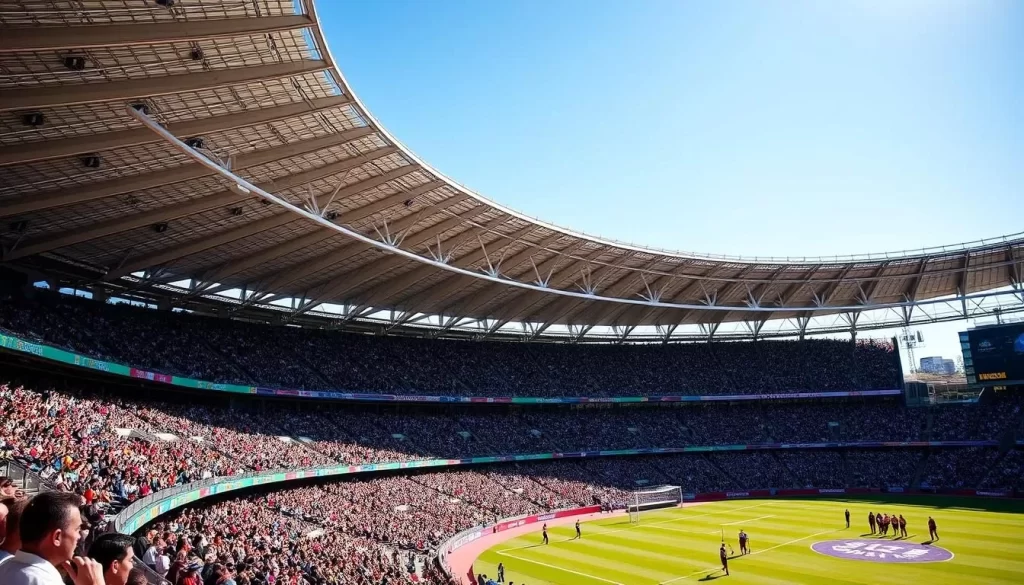
To make the most of your visit, plan ahead by checking the schedules for these events and booking your tickets in advance. You can also experience the city’s sporting culture by visiting sports bars and venues that show live games.
Conclusion: Making the Most of Your Pretoria Visit
From historical landmarks to vibrant cultural experiences and serene natural escapes, Pretoria is a city that has something for everyone. As you plan your visit, you’ll find that this South African city offers a unique blend of history, culture, and natural beauty that caters to a wide range of interests.
Essential Experiences in Pretoria
Your itinerary should include visits to iconic sites such as the Union Buildings and Gardens, the Voortrekker Monument, and Freedom Park, each offering a glimpse into the city’s rich history and cultural heritage. The National Zoological Gardens and the Pretoria Botanical Gardens are must-visits for nature lovers, providing a serene escape from the city’s bustle.
Crafting Your Itinerary
Depending on your interests, you can tailor your trip to focus on historical sites, cultural experiences, family-friendly activities, or nature-focused explorations. For history buffs, the Melrose House Museum and the Ditsong National Museum of Natural History are invaluable resources. Those looking for cultural experiences can enjoy the Pretoria Art Museum and the vibrant street food scene.
Pretoria in the Broader South African Context
Pretoria is an ideal base for exploring the surrounding region, with day trips to the Cullinan Diamond Mine, Dinokeng Game Reserve, and Hartbeespoort Dam offering a mix of adventure and relaxation. Understanding how Pretoria fits into the broader South African travel experience can help you make the most of your trip.
Maximizing Your Time
To have authentic experiences, consider engaging with locals through community events or guided tours. This not only provides deeper insights into South African culture but also allows you to explore beyond the obvious tourist attractions. By doing so, you’ll create lasting memories and gain a deeper appreciation for Pretoria’s distinctive character.
Connecting with Locals and Exploring Beyond
Pretoria’s festivals and events, such as the Jacaranda Festival, offer a unique glimpse into the city’s culture and community spirit. By participating in these events and venturing into the local neighborhoods, you can experience the authentic Pretoria and contribute to the community of visitors who are passionate about this city.
As you conclude your journey through Pretoria, we invite you to share your experiences and insights, helping to enrich the travel community’s understanding of this remarkable city. Whether you’re drawn to its historical significance, cultural vibrancy, or natural beauty, Pretoria is a destination that leaves a lasting impression on all who visit.
The above is subject to change.
Check back often to TRAVEL.COM for the latest travel tips and deals.
